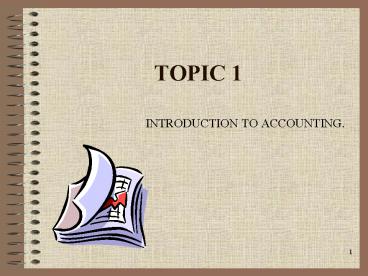INTRODUCTION TO ACCOUNTING. - PowerPoint PPT Presentation
1 / 17
Title:
INTRODUCTION TO ACCOUNTING.
Description:
Accounting is the 'language of business' Accounting is the ... works with the SEC (Securities and Exchange Commission) and the AICPA (American Institute of Certified Public Accountants) ... – PowerPoint PPT presentation
Number of Views:2284
Avg rating:3.0/5.0
Title: INTRODUCTION TO ACCOUNTING.
1
TOPIC 1
- INTRODUCTION TO ACCOUNTING.
2
ACCOUNTING - THE BASIS OF DECISION MAKING
- Accounting is the language of business
- Accounting is the information system that
- Measures business activities
- Processes that information into reports
- Communicates the results to decision makers
3
- THE ACCOUNTING SYSTEM
- THE FLOW OF INFORMATION
1. People make decisions
2. Business transactions occur
3. Businesses prepare reports to show the
results of their operations
4
ACCOUNTING VS. BOOKKEEPING
- Bookkeeping is the procedural element of
accounting that processes the accounting data
5
TYPES OF BUSINESS ORGANIZATIONS
Proprietorships Have a single owner who is
generally the manager Are business entities, but
not legal entities Have debt for which the
proprietor is personally liable
6
TYPES OF BUSINESS ORGANIZATIONS
Partnerships Join two or more persons together as
co-owners Are business entities, but not legal
entities Have debt for which each partner is
personally liable
7
TYPES OF BUSINESS ORGANIZATIONS
Corporations Are owned by stockholders or
shareholders Are business entities and legal
entities Are liable for all debts Stockholders
have no personal obligation for corporation debts
8
DECISION MAKERS WHO USE ACCOUNTING INFORMATION
- Individuals
- Businesses
- Investors and Creditors
- Government Regulatory Agencies
- Taxing Authorities
- Nonprofit Organizations
9
FINANCIAL ACCOUNTING AND MANAGEMENT ACCOUNTING
- Financial accounting provides information to
managers and people outside the firm - Financial accounting information must meet
certain standards of relevance and reliability - Management accounting generates confidential
information for internal decision makers, e.g., - Top executives
- Department heads
10
QUALITATIVE CHARACTERISTICS OF ACCOUNTING
INFORMATION
Relevance Materiality Prediction view
Retrospective view. Realiability Neutrality
Comparability Completeness. Understandability Con
straint on Relevant and reliable Information
Timeliness Balance between Benefit and Cost
11
ACCOUNTING PRINCIPLES AND CONCEPTS
- Generally accepted accounting principles (GAAP)
are - The rules that govern how accountants operate
- Based upon a conceptual framework written by the
Financial Accounting Standards Board (FASB)
12
ACCOUNTING PRINCIPLES AND CONCEPTS
- The FASB works with the SEC (Securities and
Exchange Commission) and the AICPA (American
Institute of Certified Public Accountants)
13
ACCOUNTING PRINCIPLES AND CONCEPTS
- The entity concept
- States that an organization is an economic entity
that keeps its affairs separate from those of the
owner(s) - The reliability (objective) principle
- States that accounting records and statements are
based on the most reliable data available and
documented by objective evidence
14
ACCOUNTING PRINCIPLES AND CONCEPTS
- The cost principle
- States that acquired assets and services should
be recorded at their actual (historical) cost and
should maintain that historical cost for as long
as they are owned - The going-concern concept
- States that the entity will remain in operation
for the foreseeable future
15
ACCOUNTING PRINCIPLES AND CONCEPTS
- The stable-monetary-unit concept
- States that each dollar has the same purchasing
power as any other dollar at any other time
16
CONCEPT OF ACCOUNTING
- Accounting is a information system that measures
business activities, processes that information
into reports, and comunicates the results to
decision markers and other users of accounting
information.
17
END OF TOPIC 1































